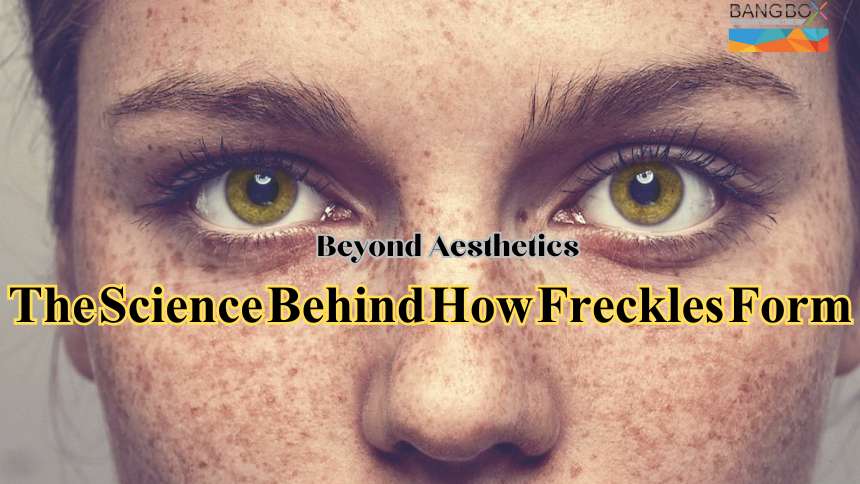
Beyond Aesthetics: The Science Behind How Freckles Form
Don't worry about freckles on your face they are harmless! Read this blog to find out how you can prevent yourself from freckles
Freckles are little flat patches that often appear on parts of your body that are exposed to light. They come in tan, light, or dark brown colors. Freckles are quite common and don't cause any health risks. They appear more frequently in the summer. If you have a lighter complexion, you are more likely to get freckles. However, freckles may affect anyone and if you have darker skin they will look like deeper brown patches. Doctors refer to them as ephelids.
HOW FRECKLES DEVELOP
An excessive amount of melanin produces freckles. Melanin is a pigment that gives color to your eyes, skin, and hair also known as your complexion. Melanin, which is created by skin cells called melanocytes, shields your skin from UV rays damage by both absorbing and reflecting it. Your melanocytes will produce more melanin when your skin is exposed to the sun if you have a light or fair complexion. Freckles are more likely to develop on fair skin exposure to the sun instead of getting tanned.
TYPES OF FRECKLES:
There are two types of Freckles ephelides and solar lentigines although both are flat they are different in some ways:
Ephelides are typically flat and red, tan, or brown. They are primarily produced by sun exposure and sunburns. They often develop on the face, arms, upper chest, neck, and back, which are body parts exposed to the sun. Ephelides are more common in those with lighter skin and hair colors. They are often found in white and Asian-American persons. Young children who are exposed to light frequently get ephelides in their early years. Ephelides continue to grow until they are young adults. Ephelides commonly lose color with aging. They can fade in winter and are typically 1-2 millimeters or can be bigger.
Solar lentigines are skin patches that range in color from yellow to dark brown. Actinic lentigines, liver spots, and age spots are the other names for them. Since they typically appear in persons over the age of 40. They are generally produced by long-term sun exposure, and they may be seen on exposed skin on your face, forearms, back of your hands, chest, back, shoulders, and lower thighs. They don't fade in any season and show up on your skin as a result of sun exposure and aging.
REASONS OF GETTING FRECKLES
Freckles develop most commonly due to sun exposure the harmful radiation of UVA and UVB rays produce these dark round or irregular spots over your face. Other causes of getting freckles can be involved in genetics. Some people have inherited genes that develop freckles over some time when they grow up. Another reason behind getting freckles can be Xeroderma Pigmentosum which is a rare disease that causes extreme sensitivity in people towards ultraviolet light such as sun exposure.
FRECKLES TREATMENT
Freckles cannot completely disappear but some treatments and products are there to lighten up their appearance.
· Try using alpha hydroxy acid, trichloracetic acid, glycolic acid, or phenol-containing acid and chemical peel products. These products help in the creation of new skin cells by causing the top layer of skin cells to peel off.
· Retinol and retinoid products encourage the skin cells to peel off so the top layer with new cells can be produced on the surface. They also boost collagen production which in turn increases cell production in the skin.
· Lasers also help in removing the top layer of your skin.
· Cryotherapy is a procedure that uses liquid nitrogen to freeze non-cancerous and actinic keratosis spots. The treatment causes the area spots to get dark and peel off in a few days.
You should always consult your dermatologist she will guide you on the best that treatment is favorable for your skin and age.
FRECKLE PREVENTION
Sun exposure is the main leading reason for freckles, the best way to prevent your skin from freckles is to avoid sun exposure.
· Before going outside cover all exposed skin with a broad-spectrum and water-resistant sunscreen that has an SPF of 30 or higher. Every day even on cloudy days and during the winter you should use sunscreen. If you're swimming or sweating reapply the sunscreen after every two hours.
· You should dress up properly before going out for sun exposure. Wear a hat cover your sleeves with light breathable cloth or shirts, and wear sunglasses with UV protection lenses. Look for clothes that have extra protection UV labels on them.
· Avoid doing outdoor chores during the peak UV hours from 10 a.m. to 4 p.m.
FRECKLES ON LIPS
Anywhere on your body, even your lips can get freckles. Your lips' skin is a component of your epidermis which is your skin's topmost layer. Freckles on the lips are often not harmful. But if you detect any changes, you should constantly keep an eye on your spots and visit your dermatologist. Lip freckles may resemble moles or a lesion. Dark stains on various parts of your body, such as your lips, are one of the leading signs of a genetic illness referred to as Peutz-Jeghers syndrome.
WHITE FRECKLES ON THE SKIN
Idiopathic guttate hypomelanosis, often known as the white freckles is assumed to be a result of repeated or long-term sun exposure. Similar to other forms of freckles they are more frequently found on fair-skinned people while they can also be found on older, darker-skinned people. Legs, arms, upper back, and face are the most affected body parts. The absence of melanin in your skin is what's causing the white patches to produce on your skin. Idiopathic guttate hypomelanosis is not a harmful condition. Topical steroid creams, tretinoin, pimecrolimus, and dermabrasion creams are among the available treatment options in the market.
DO FRECKLES NEED TREATMENT
All forms of freckles are almost harmless there's no need to treat them. It is similar to other skin lesions or spots though, it's best to avoid sun exposure and make wearing sunscreen your daily habit before going outside. This is the easiest way you can do to prevent yourself from getting freckles. You need to consult your dermatologist if you feel itchiness, soreness, or blood in your freckles. Otherwise, freckles are not harmful at all they are as common as any other skin spot or discoloration.





